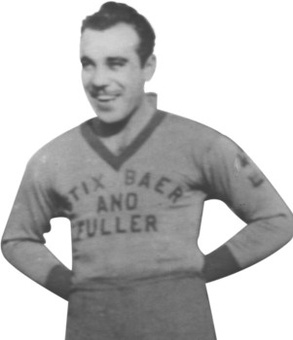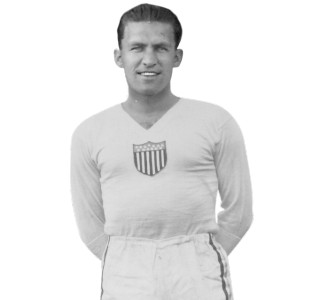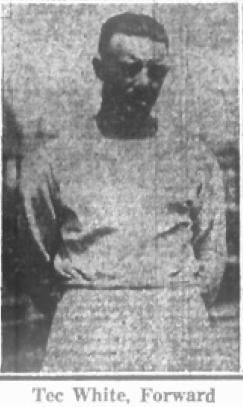Related Research Articles

James T. Kennaway, commonly known as Joe Kennaway, was a dual international football goalkeeper. He began his career in Canada, spent four years in the American Soccer League before finishing his career with Celtic in the Scottish Football League. He later coached the Brown University soccer team from 1946 to 1959.

Adelino William Gonsalves was an American soccer player, sometimes described as the "Babe Ruth of American Soccer". He spent over 25 years playing in various American professional leagues and was a member of the U.S. squad at the FIFA World Cup in 1930 and 1934. He is a member of the National Soccer Hall of Fame.
Fall River F.C. was an American soccer club based in Fall River, Massachusetts. During the 1920s and early 1930s they were one of the most successful soccer clubs in the United States, winning the American Soccer League on six occasions. They also won the National Challenge Cup four times. In 1924 they won the first ASL / Challenge Cup double and were subsequently the American soccer champions three times in succession. Between 1928 and 1930 they won a further three titles in a row. In 1930 they completed a treble, winning the ASL title, the Challenge Cup and the Lewis Cup. The same year they also toured Central Europe.
William Harper was a Scottish goalkeeper who played for, among others, Hibernian, Arsenal, Fall River F.C. and Plymouth Argyle. He also represented Scotland in 11 full internationals.

Stix, Baer and Fuller F.C. was a U.S. soccer club which played in the St. Louis Soccer League from 1931 to 1934. The team was known as Hellrungs from 1929 to 1931, St. Louis Central Breweries F.C. from 1934 to 1935 and St. Louis Shamrocks from 1935 to 1938. During its short existence, it won two National Challenge Cup titles and two league championships as Stix, Baer and Fuller and one National Cup and league title as St. Louis Central Breweries.

Werner "Scotty" Nilsen was a former soccer player who played as a forward. He is one of the highest scoring players in United States soccer history, scoring 131 goals in 239 games with the Boston Soccer Club. He won five consecutive National Challenge Cups during his career, and four doubles. Born in Norway, he earned two caps with the United States national team in 1934. He is a member of the National Soccer Hall of Fame.
Edward Hart was a former U.S. soccer forward who was a member of the U.S. soccer team at the 1924 Summer Olympics. He spent most of his professional career in the St. Louis Soccer League with one game in the American Soccer League.

William Stewart Lang was a Scottish-born American soccer player. A dominant player through the 1930s and a member of the U.S. national team at the 1934 FIFA World Cup, McLean disappeared without a trace in 1938. His disappearance remained a mystery until June 2022, when an investigation by The Athletic's Pablo Maurer and Matt Pentz uncovered the details behind that disappearance; McLean had suffered a nervous breakdown after multiple head injuries and lived out the last 40 years of his life in a series of public mental health facilities.
Walter Dick was a U.S. soccer forward who was a member of the U.S. national team at the 1934 FIFA World Cup. He is a member of the U.S. National Soccer Hall of Fame.
James Harry Chatton, was an Irish footballer who played for several clubs in the Scottish League, the American Soccer League and the League of Ireland. Chatton was a dual internationalist and played for both Ireland teams – the IFA XI and the FAI XI.

Alexander McNab was a Scottish-American soccer player and coach. He began his career in Scotland before moving to the United States. In the US, he won six consecutive National Challenge Cups with teams from both the American Soccer League and St. Louis Soccer League. He was inducted into the National Soccer Hall of Fame in 2005.

William McPherson was a Scottish-American soccer wing half. He began his career in Scotland before moving to the American Soccer League. He also spent time in the St. Louis Soccer League, winning a total of five league titles and seven National Challenge Cups during his career.
Andy Stevens was an English-Canadian soccer center forward who began and ended his career in Canada but also spent six seasons in the American Soccer League. He was a two time league leading scorer with the ASL and was a member of the Canada Soccer Hall of Fame's 2006 Team of Distinction, the 1933 Toronto Scottish. In 2017, as part of the "Legends Class" he was elected to the Hall of Fame as an individual player.
James McGuire was a two-time president of the United States Soccer Football Association. He played professionally in the American Soccer League and the English Football League. He also earned two schoolboy caps with Scotland and was inducted into the National Soccer Hall of Fame in 1951.
Ernő Schwarz or Schwarcz was a Hungarian American soccer player, coach and promoter who served as head coach of the United States men's national soccer team. He played professionally in Hungary, Czechoslovakia, Austria and the United States, earning two caps, scoring two goals, with the Hungarian national team in 1922. Schwarz founded, owned, managed and played for the New York Americans in the first and second American Soccer Leagues. He was also the ASL and International Soccer League vice president. His daughter was married to United States national team player Ben Zinn.

James White was a Scottish footballer who spent most of his career playing for Fall River in the American Soccer League. He was born in Airdrie, North Lanarkshire, Scotland.

Gerrit Visser was a Dutch football who played as a center forward in the Netherlands, the United States, and Canada. He was a member of the Netherlands football team at the 1924 Summer Olympics, and earned seven caps, scoring one goal, with the Netherlands national football team.
Billy Watson was a Scottish-American soccer left half. He began his career in Scotland before moving to England and then the United States where he played in both the American Soccer League and St. Louis Soccer League.
Clem Cuthbert was a Scottish-American soccer player who spent his career in the Chicago leagues.
Art Halliwell was a Canadian soccer player who played as a goalkeeper at the international level with Canada.
References
- ↑ Jose, Colin (1998). American Soccer League, 1921-1931 (Hardback). The Scarecrow Press. ISBN 0-8108-3429-4. ().
- ↑ USA - List of US Open Cup Finals Archived 13 May 2011 at the Wayback Machine
- ↑ Winners Medal for Bob Gregg - 1935 National Challenge Cup
- ↑ English F.A Tour 1926
- ↑ Scottish F.A Tour 1927
- ↑ Glasgow Celtic North America Tour 1931